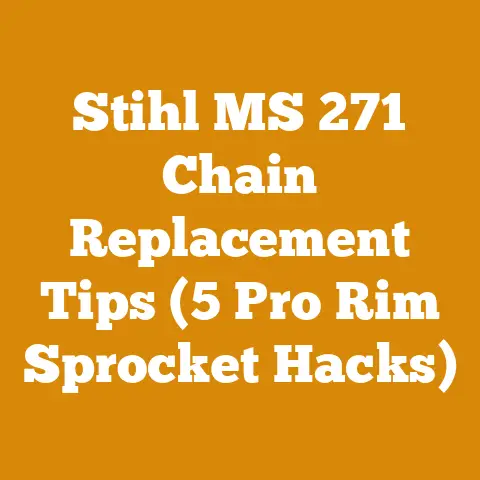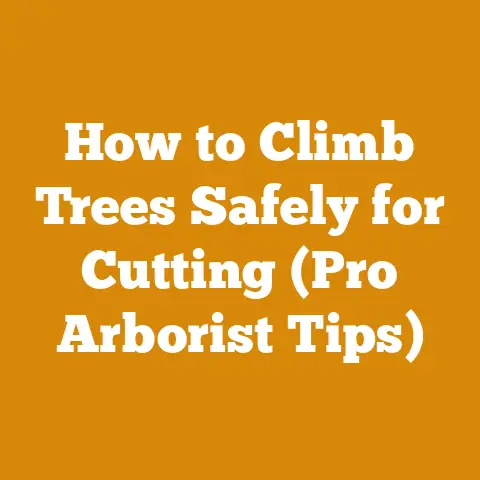Kousa Dogwood Pruning Tips (Expert Arborist Chainsaw Guide)
The biggest challenge I see time and again, especially with folks new to tree care, is the assumption that all trees respond the same way to pruning.
They don’t.
And that’s especially true for Kousa Dogwoods.
I’ve seen perfectly healthy Kousas butchered into misshapen messes because someone treated them like they were pruning an apple tree.
It’s a heartbreaker.
My intention with this guide is to prevent that heartbreak.
I want to equip you with the knowledge and understanding to prune your Kousa Dogwood not just correctly, but beautifully, so it thrives and enhances your landscape for years to come.
This isn’t just about lopping off branches; it’s about understanding the tree’s growth habits, its unique needs, and how to work with it, not against it.
I’ll share my experiences, the lessons I’ve learned the hard way, and the specific techniques I’ve found most effective over years of working with these stunning trees.
Get your chainsaw ready, but more importantly, get your mind ready to learn!
Understanding the Kousa Dogwood: A Foundation for Pruning
Before even thinking about firing up the chainsaw, it’s crucial to understand the Kousa Dogwood ( Cornus kousa).
This isn’t just about knowing its name; it’s about appreciating its growth habit, its vulnerabilities, and its strengths.
Growth Habits and Characteristics
Kousa Dogwoods are known for their vase-shaped or rounded crown, which sets them apart from the more horizontally branching American Dogwood.
They typically reach a height of 15-25 feet with a similar spread.
The bark is another distinguishing feature, developing a mottled, exfoliating pattern with age, revealing shades of tan, gray, and brown.
- Growth Rate: Moderate, adding about 1-2 feet per year under optimal conditions.
- Bloom Time: Late spring to early summer, after the leaves emerge.
The “flowers” are actually bracts, typically white or pink. - Fruit: Produces edible, raspberry-like fruits in late summer to early fall.
While edible, I find the texture a bit mealy.
Birds, however, love them. - Sunlight: Prefers full sun to partial shade. More sun generally leads to better flowering.
- Soil: Well-drained, acidic soil is ideal. Kousas don’t tolerate wet feet.
Common Issues and Vulnerabilities
Understanding potential problems helps guide pruning decisions.
Kousa Dogwoods are generally more resistant to dogwood anthracnose than American Dogwoods, but they’re not immune to other issues.
- Dogwood Borer: A common pest that can weaken the tree.
Signs include sawdust at the base of the trunk or branches. - Powdery Mildew: Can occur in humid conditions, causing a white coating on the leaves.
- Branch Dieback: Can be caused by various factors, including stress, disease, or injury.
- Sunscald: Young trees, especially those recently planted, are susceptible to sunscald on their thin bark.
Why Prune a Kousa Dogwood?
Pruning isn’t just about aesthetics; it’s about the health and longevity of the tree.
Here are the key reasons I prune Kousa Dogwoods:
- Removing Dead, Damaged, or Diseased Wood (The 3 D’s): This is the most critical reason.
Deadwood is an invitation for pests and diseases. - Improving Air Circulation: A dense canopy can trap moisture and create a breeding ground for fungal diseases.
Opening up the canopy promotes airflow, reducing this risk. - Enhancing Sunlight Penetration: Sunlight is essential for photosynthesis and flower production.
Pruning to allow more light into the interior of the tree encourages better flowering. - Shaping the Tree: Pruning can help maintain the tree’s natural shape and prevent it from becoming overgrown.
- Improving Fruit Production: While Kousa Dogwood fruits are edible, they’re not typically the primary reason for growing the tree.
However, pruning can improve fruit production by increasing sunlight exposure. - Structural Integrity: Removing crossing or rubbing branches prevents them from causing wounds that can lead to decay.
- Safety: Removing low-hanging branches that obstruct walkways or driveways.
Timing is Everything: When to Prune
The timing of pruning is crucial for the health and vigor of the tree.
The best time to prune Kousa Dogwoods is in late winter or early spring, before new growth begins.
Why Late Winter/Early Spring?
- Dormancy: The tree is dormant, so pruning wounds heal more quickly and the risk of disease transmission is lower.
- Visibility: You can easily see the tree’s structure without leaves obscuring your view.
This allows you to make more informed pruning decisions. - Reduced Stress: Pruning before new growth minimizes stress on the tree.
Avoiding Fall Pruning
I strongly advise against pruning Kousa Dogwoods in the fall.
Fall pruning can stimulate new growth that is vulnerable to winter damage.
Additionally, fungal spores are more prevalent in the fall, increasing the risk of infection.
Exception: Removing Deadwood
Dead, damaged, or diseased wood can be removed at any time of year.
However, it’s best to address significant issues during the dormant season.
Bloom Cycle Considerations
Kousa Dogwoods bloom on old wood (the previous year’s growth).
While pruning in late winter/early spring may remove some flower buds, the benefits of pruning outweigh the potential loss of blooms.
A light pruning will still allow for ample flowering.
Avoid heavy pruning right before bloom if you want to maximize flower display.
Essential Tools and Safety Gear
Using the right tools and wearing appropriate safety gear are paramount.
Never compromise on safety.
I’ve seen too many accidents, and none of them are worth it.
Chainsaw Selection and Maintenance
For larger branches (over 2-3 inches in diameter), a chainsaw is often necessary.
Choosing the right chainsaw and maintaining it properly are crucial.
- Chainsaw Size: For pruning Kousa Dogwoods, a lightweight chainsaw with a 14-16 inch bar is usually sufficient.
I personally prefer a battery-powered chainsaw for its ease of use and reduced noise. - Chain Sharpness: A sharp chain is essential for safe and efficient cutting.
A dull chain can kick back and cause injury.
Sharpen your chain regularly, or have it professionally sharpened.
I touch up my chain after every few cuts with a small file. - Chain Tension: Proper chain tension is also crucial.
A loose chain can derail and cause injury.
Refer to your chainsaw’s manual for instructions on adjusting chain tension. - Bar Oil: Keep the bar oil reservoir filled to lubricate the chain and bar.
- Air Filter: Clean the air filter regularly to ensure proper engine performance.
- Spark Plug: Replace the spark plug annually or as needed.
- Safety Features: Ensure your chainsaw has a chain brake, a throttle lock, and a chain catcher.
Test these features regularly.
Hand Pruners and Loppers
For smaller branches (under 1 inch in diameter), hand pruners are ideal.
Loppers are useful for branches between 1 and 2 inches in diameter.
- Bypass Pruners: Bypass pruners are preferred over anvil pruners because they make a cleaner cut, reducing the risk of disease.
- Loppers: Loppers provide more leverage for cutting thicker branches.
- Sharpness: Keep your hand pruners and loppers sharp.
Dull blades can crush branches and make it difficult to make clean cuts. - Cleaning: Clean your tools regularly with rubbing alcohol or a bleach solution to prevent the spread of disease.
Pole Saw
A pole saw is useful for reaching high branches without using a ladder.
- Telescoping Pole Saw: A telescoping pole saw allows you to adjust the length of the pole.
- Chain Saw Attachment: Some pole saws have a chainsaw attachment for cutting thicker branches.
- Safety: Use caution when using a pole saw, especially near power lines.
Safety Gear: Non-Negotiable
- Eye Protection: Wear safety glasses or a face shield to protect your eyes from flying debris.
This is absolutely essential when using a chainsaw. - Hearing Protection: Chainsaws are loud.
Wear earplugs or earmuffs to protect your hearing.
Prolonged exposure to chainsaw noise can cause permanent hearing damage.
I use noise-canceling headphones that also allow me to listen to music. - Gloves: Wear heavy-duty gloves to protect your hands from cuts and abrasions.
- Long Sleeves and Pants: Wear long sleeves and pants to protect your skin from scratches and cuts.
- Steel-Toed Boots: Wear steel-toed boots to protect your feet from falling branches and chainsaw injuries.
- Chainsaw Chaps: If you’re using a chainsaw, wear chainsaw chaps to protect your legs.
Chainsaw chaps are made of ballistic nylon that can stop a chainsaw chain in its tracks. - Helmet: A helmet is recommended, especially when working with a chainsaw or pole saw.
Chainsaw Calibration and Safety Checks
Before each use, I perform a series of checks on my chainsaw:
- Chain Tension: Ensure the chain is properly tensioned.
A good rule of thumb is that you should be able to pull the chain away from the bar slightly, but not so much that it comes completely off. - Chain Sharpness: Check the chain for sharpness.
If it’s dull, sharpen it before using the chainsaw. - Bar Oil Level: Check the bar oil level and fill as needed.
- Fuel Level: Check the fuel level (if using a gas-powered chainsaw) and fill as needed.
- Chain Brake: Test the chain brake to ensure it’s working properly.
- Throttle Lock: Test the throttle lock to ensure it’s working properly.
- Overall Condition: Inspect the chainsaw for any signs of damage or wear.
Pruning Techniques: A Step-by-Step Guide
Now that you understand the Kousa Dogwood, the timing of pruning, and the necessary tools and safety gear, let’s dive into the actual pruning techniques.
The Three-Cut Method for Larger Branches
When removing larger branches (over 2 inches in diameter), use the three-cut method to prevent bark tearing.
This is crucial to avoid damaging the trunk.
- Undercut: Make an undercut about 1/3 of the way through the branch, a few inches away from the branch collar (the swollen area where the branch joins the trunk).
- Top Cut: Make a top cut a few inches further out from the undercut.
The branch will break off between these two cuts. - Final Cut: Make the final cut just outside the branch collar, being careful not to damage the collar.
Angle the cut slightly away from the trunk.
Pruning Smaller Branches
For smaller branches (under 2 inches in diameter), you can use hand pruners or loppers.
Make a clean cut just outside the branch collar, angling the cut slightly away from the trunk.
Removing Dead, Damaged, or Diseased Wood
- Deadwood: Remove deadwood back to healthy wood.
Look for signs of life, such as green buds or healthy bark. - Damaged Wood: Remove damaged wood back to healthy wood.
- Diseased Wood: Remove diseased wood and dispose of it properly to prevent the spread of disease.
Do not compost diseased wood.
Burn it or dispose of it in the trash.
Thinning the Canopy
Thinning the canopy involves removing branches to improve air circulation and sunlight penetration.
- Crossing Branches: Remove crossing branches that rub against each other.
These branches can create wounds that lead to decay. - Rubbing Branches: Remove rubbing branches that rub against other branches.
- Weak Branches: Remove weak branches that are unlikely to survive.
- Water Sprouts: Remove water sprouts (vigorous, upright shoots that grow from the trunk or branches).
- Suckers: Remove suckers (shoots that grow from the base of the tree).
Shaping the Tree
Pruning can help maintain the tree’s natural shape and prevent it from becoming overgrown.
- Maintain Natural Shape: Prune to maintain the tree’s natural vase-shaped or rounded crown.
- Remove Overgrown Branches: Remove overgrown branches that detract from the tree’s shape.
- Balance the Canopy: Prune to balance the canopy and create a symmetrical shape.
Heading Cuts vs. Thinning Cuts
Understanding the difference between heading cuts and thinning cuts is essential for proper pruning.
- Heading Cuts: Heading cuts involve cutting a branch back to a stub or a lateral branch.
Heading cuts stimulate new growth near the cut, creating a dense, bushy appearance.
I generally avoid heading cuts on Kousa Dogwoods, as they can disrupt the tree’s natural shape. - Thinning Cuts: Thinning cuts involve removing an entire branch at its point of origin.
Thinning cuts improve air circulation and sunlight penetration without stimulating excessive new growth.
I prefer thinning cuts for Kousa Dogwoods.
Pruning for Fruit Production
While Kousa Dogwood fruits are edible, they’re not typically the primary reason for growing the tree.
However, pruning can improve fruit production by increasing sunlight exposure.
- Remove Shade: Remove branches that shade the interior of the tree.
- Encourage Air Circulation: Improve air circulation to reduce the risk of fungal diseases that can affect fruit production.
Case Studies: Real-World Pruning Examples
To illustrate these techniques, let’s look at a few real-world pruning examples.
Case Study 1: Overgrown Kousa Dogwood
I was called to prune a Kousa Dogwood that had been neglected for several years.
The tree was overgrown, with a dense canopy and numerous crossing and rubbing branches.
- Assessment: The tree was healthy overall, but the dense canopy was restricting air circulation and sunlight penetration.
- Pruning: I started by removing dead, damaged, and diseased wood.
Then, I thinned the canopy by removing crossing and rubbing branches.
I also removed some weak branches and water sprouts.
Finally, I shaped the tree to maintain its natural form. - Results: The tree looked much healthier and more attractive after pruning.
Air circulation and sunlight penetration were significantly improved.
Case Study 2: Kousa Dogwood with Dogwood Borer
I was called to treat a Kousa Dogwood infested with dogwood borer.
- Assessment: The tree had several boreholes in the trunk and branches, with sawdust at the base of the tree.
- Pruning: I removed any branches that were heavily infested with dogwood borer.
I also removed any dead or damaged wood. - Treatment: I treated the tree with an insecticide specifically designed to control dogwood borer.
- Results: The dogwood borer infestation was controlled. The tree recovered and continued to thrive.
Case Study 3: Young Kousa Dogwood Pruning
I was asked to prune a young Kousa Dogwood that had been recently planted.
- Assessment: The tree was healthy and well-established.
The goal was to shape the tree and encourage proper growth. - Pruning: I removed any crossing or rubbing branches.
I also removed any suckers or water sprouts.
Finally, I shaped the tree to maintain its natural form. - Results: The tree developed a strong, healthy structure.
Troubleshooting Common Pruning Mistakes
Even with the best intentions, mistakes can happen.
Here are some common pruning mistakes and how to avoid them.
Over-Pruning
Over-pruning can stress the tree and make it more susceptible to pests and diseases.
A good rule of thumb is to remove no more than 25% of the tree’s canopy in a single year.
Topping
Topping involves cutting off the top of the tree.
Topping is a harmful practice that can weaken the tree and make it more susceptible to disease.
I strongly advise against topping Kousa Dogwoods.
Leaving Stubs
Leaving stubs when pruning can lead to decay.
Always make clean cuts just outside the branch collar.
Damaging the Branch Collar
Damaging the branch collar can prevent the wound from healing properly.
Be careful not to cut into the branch collar when pruning.
Using Dull Tools
Using dull tools can crush branches and make it difficult to make clean cuts.
Keep your tools sharp and clean.
Pruning at the Wrong Time of Year
Pruning at the wrong time of year can stress the tree and make it more susceptible to pests and diseases.
Prune Kousa Dogwoods in late winter or early spring.
Post-Pruning Care: Ensuring a Healthy Recovery
After pruning, it’s important to provide proper care to help the tree recover.
Watering
Water the tree deeply after pruning, especially if the weather is dry.
Fertilizing
Fertilize the tree in the spring with a balanced fertilizer.
I prefer a slow-release fertilizer.
Mulching
Apply a layer of mulch around the base of the tree to help retain moisture and suppress weeds.
Keep the mulch a few inches away from the trunk to prevent rot.
Monitoring
Monitor the tree for signs of stress or disease.
If you notice any problems, consult with a certified arborist.
Wound Treatment
While some arborists recommend wound treatments, I generally don’t use them unless the wound is very large or susceptible to infection.
Research suggests that wound treatments don’t necessarily speed up healing and can sometimes trap moisture, creating a favorable environment for decay.
If you do choose to use a wound treatment, use a product specifically designed for trees.
Avoid using petroleum-based products, as they can be harmful to the tree.
Technical Specifications and Standards
For those interested in the more technical aspects of pruning, here are some relevant specifications and standards.
ANSI A300 Standards
The ANSI A300 standards are the industry-accepted standards for tree care practices.
These standards cover a wide range of topics, including pruning, fertilization, and pest management.
Adhering to ANSI A300 standards helps ensure that you’re using best practices for tree care.
Wood Moisture Content
The moisture content of wood is an important factor to consider when pruning.
Wood with a high moisture content is more susceptible to decay.
The ideal moisture content for firewood is below 20%.
You can use a moisture meter to measure the moisture content of wood.
- Freshly Cut Wood: Typically has a moisture content of 30-60%.
- Air-Dried Wood: After several months of air drying, the moisture content will typically be 15-20%.
- Kiln-Dried Wood: Kiln-dried wood has a moisture content of 6-8%.
Chainsaw Performance Metrics
Chainsaw performance can be measured by several metrics, including:
- Cutting Speed: The speed at which the chainsaw can cut through wood.
- Vibration Level: The amount of vibration produced by the chainsaw.
- Noise Level: The amount of noise produced by the chainsaw.
- Fuel Efficiency: The amount of fuel consumed by the chainsaw.
Wood Strength
The strength of wood is an important factor to consider when pruning.
Wood that is weak or decayed is more likely to break.
The strength of wood is affected by several factors, including:
- Species: Different species of wood have different strengths.
- Moisture Content: Wood with a high moisture content is weaker than wood with a low moisture content.
- Defects: Defects such as knots and cracks can weaken wood.
Sourcing Materials and Tools Globally
Sourcing materials and tools can be challenging, especially in certain parts of the world.
Here are some tips for sourcing materials and tools globally.
Local Suppliers
Start by checking with local suppliers.
Local suppliers are often the most convenient and cost-effective option.
Online Retailers
Online retailers offer a wide selection of materials and tools.
However, be sure to factor in shipping costs and import duties.
International Distributors
International distributors can provide access to materials and tools that may not be available locally.
Quality Considerations
When sourcing materials and tools, be sure to consider quality.
Cheap tools may not last as long and may not be as safe to use.
Conclusion: Pruning with Purpose
Pruning Kousa Dogwoods is more than just trimming branches; it’s about understanding the tree’s needs and working to enhance its health, beauty, and longevity.
By following the techniques and guidelines I’ve outlined, you can confidently prune your Kousa Dogwood and enjoy its beauty for years to come.
Remember to prioritize safety, use the right tools, and prune with a clear purpose in mind.
And don’t be afraid to seek professional help if you’re unsure about any aspect of the pruning process.
Happy pruning!






